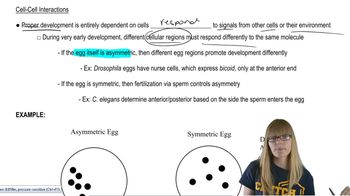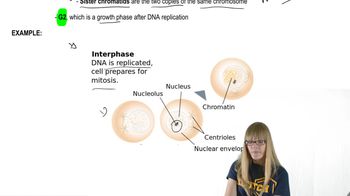Table of contents
- 1. Introduction to Genetics51m
- 2. Mendel's Laws of Inheritance3h 37m
- 3. Extensions to Mendelian Inheritance2h 41m
- 4. Genetic Mapping and Linkage2h 28m
- 5. Genetics of Bacteria and Viruses1h 21m
- 6. Chromosomal Variation1h 48m
- 7. DNA and Chromosome Structure56m
- 8. DNA Replication1h 10m
- 9. Mitosis and Meiosis1h 34m
- 10. Transcription1h 0m
- 11. Translation58m
- 12. Gene Regulation in Prokaryotes1h 19m
- 13. Gene Regulation in Eukaryotes44m
- 14. Genetic Control of Development44m
- 15. Genomes and Genomics1h 50m
- 16. Transposable Elements47m
- 17. Mutation, Repair, and Recombination1h 6m
- 18. Molecular Genetic Tools19m
- 19. Cancer Genetics29m
- 20. Quantitative Genetics1h 26m
- 21. Population Genetics50m
- 22. Evolutionary Genetics29m
9. Mitosis and Meiosis
Mitosis
Problem 11d
Textbook Question
Describe the role of the following structures or proteins in cell division:
cohesin protein
 Verified step by step guidance
Verified step by step guidance1
Cohesin is a protein complex that plays a crucial role in holding sister chromatids together after DNA replication.
During the S phase of the cell cycle, cohesin forms a ring-like structure around the sister chromatids, ensuring they remain attached.
This attachment is essential for proper chromosome alignment and segregation during mitosis and meiosis.
In the metaphase stage of cell division, cohesin helps align the sister chromatids at the metaphase plate.
At the onset of anaphase, cohesin is cleaved by the enzyme separase, allowing sister chromatids to separate and move to opposite poles of the cell.
Recommended similar problem, with video answer:
 Verified Solution
Verified SolutionThis video solution was recommended by our tutors as helpful for the problem above
Video duration:
2mPlay a video:
Was this helpful?
Key Concepts
Here are the essential concepts you must grasp in order to answer the question correctly.
Cohesin Protein
Cohesin is a protein complex that plays a crucial role in holding sister chromatids together during cell division. It forms a ring-like structure that encircles the chromatids, ensuring they remain attached until the appropriate stage of mitosis or meiosis. This attachment is vital for accurate chromosome segregation, preventing aneuploidy, which can lead to various genetic disorders.
Recommended video:
Guided course

Proteins
Cell Division
Cell division is the process by which a parent cell divides into two or more daughter cells. It encompasses two main types: mitosis, which results in two identical daughter cells for growth and repair, and meiosis, which produces gametes for sexual reproduction. Proper regulation of cell division is essential for maintaining genetic stability and organismal development.
Recommended video:
Guided course

Cell-cell interactions
Chromatid Separation
Chromatid separation is a critical phase in cell division where sister chromatids are pulled apart to opposite poles of the cell. This process occurs during anaphase of mitosis and meiosis, facilitated by the action of spindle fibers. The timely and accurate separation of chromatids is essential to ensure that each daughter cell receives the correct number of chromosomes.
Recommended video:
Guided course

Chromatin
Related Videos
Related Practice





